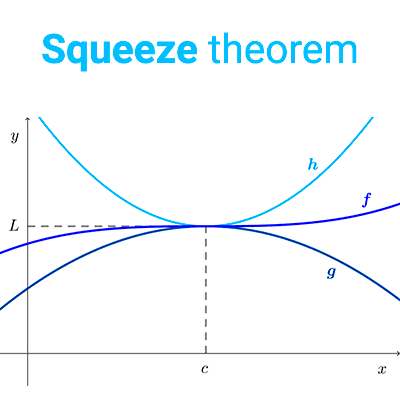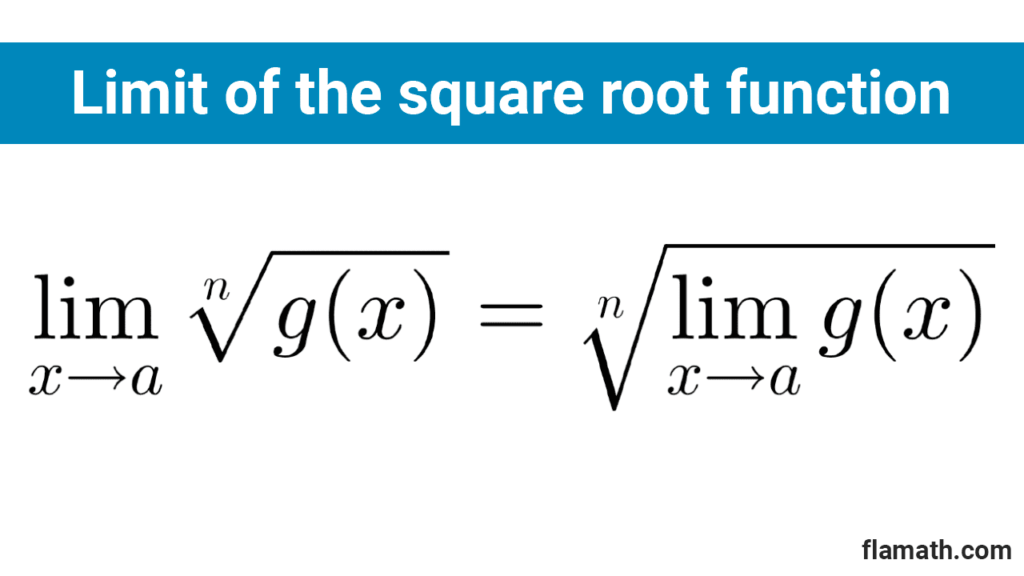
Limit of composite functions
In this article we explain a way to find the limits of composite functions at a point using an important property in calculus. Recall that these functions arise from performing a composition of functions.
Table of Contents
Introduction
When we have to evaluate a limit like *\lim_{x\to 5}\sqrt{x-1}*, it is very tempting to do
$$\lim_{x\to 5}\sqrt{x-1}=\sqrt{\lim_{x\to 5}(x-1)}=\sqrt{4}=2$$
But, is it possible to "move the limit inside the radical"? To analyze this problem, we write *f(x)=\sqrt{x}* and *g(x)=x-1.* Then, we can form the composite function
*(f\circ g)(x)=f(g(x))=\sqrt{g(x)}=\sqrt{x-1}*
This is the same function for which we needed to find the limit, and our question can be formulated in a general form as follows:
$$\lim_{x\to a} f(g(x))=f(\lim_{x\to a}g(x))$$
The following limit law confirms this statement as long as certain conditions are met.
Theorem on the limit of a composite function
Let f and g be two functions such that
- *\lim_{x\to a} g(x)=L*
- *\lim_{x\to L} f(x)=f(L)*
Then,
$$\lim_{x\to a} f(g(x))=f(\lim_{x\to a} g(x))=f(L)$$
Alternatively:
$$\lim_{x\to a} (f\circ g)(x)=f(\lim_{x\to a} g(x))$$
The conditions under which the above theorem holds are:
- The limit of the "inner function" g as *x\to a* exists and is equal to L.
- The limit of the "outer function" f as *x\to L* exists and is equal to the "expected" value of f, i.e., f(L).
If this is fulfilled, then the limit of the composite function *f(g(x))* as *x\to a* can be found by substituting into the function f the value of the limit of g(x) as *x\to a.*
In our initial example, the functions were *f(x)=\sqrt{x}* and *g(x)=x-1*, and we wanted to find the limit of *f(g(x))=\sqrt{x-1}* as *x\to 5.* The conditions required by the theorem are met, as:
- *\lim_{x\to 5}(x-1)=4*
- *\lim_{x\to 4}\sqrt{x}=\sqrt{4}=2*
Therefore, we can confidently state that:
$$\lim_{x\to 5}\sqrt{x-1}=\sqrt{\lim_{x\to 5}(x-1)}=\sqrt{4}=2$$

Note: the conditions required by the theorem can be expressed by appealing to the concept of continuity as follows:
- The limit of g at the point a exists and is equal to L.
- f is continuous at the point L.
Example:
Let *f(x)=\ln(x)* and *g(x)=\dfrac{x^3-2x^2}{x-2}.* Find the following limit:
$$\lim_{x\to 2} f(g(x))$$
First, we identify that the composite function is *f(g(x))=\ln\left(\dfrac{x^3-2x^2}{x-2}\right).* We will analyze whether the conditions required by the theorem to "move the limit" inside the logarithm are met:
1) Does the limit of *g(x)=\dfrac{x^3-2x^2}{x-2}* exist at the point *x=2*?
If we try to make a direct substitution, we get an indetermination of the form 0/0.
$$\lim_{x\to 2} \dfrac{x^3-2x^2}{x-2}=\dfrac{0}{0}$$
But, by performing factorization, we obtain a simpler expression for the function, which allows us to find the limit:
*\lim_{x\to 2} \dfrac{x^3-2x^2}{x-2}=\lim_{x\to 2} \dfrac{x^2(x-2)}{x-2}*
*=\lim_{x\to 2} \dfrac{x^2\cancel{(x-2)}}{\cancel{x-2}}*
*=\lim_{x\to 2} x^2*
*=2^2*
*=4*
Therefore, we conclude that the limit of the function at the point exists and is equal to 4:
$$\lim_{x\to 1} \dfrac{x^3-2x^2}{x-2}=4$$
2) Does the limit of *f(x)=\ln{x}* at *x=4* exist and is it equal to *f(4)*?
Indeed, because of the property of the logarithmic function:
$$\lim_{x\to 4} \ln(x)=\ln(4)=f(4)$$
We conclude that both conditions are met to apply the theorem of the composite function. So:
$$\lim_{x\to 2} \ln \left(\dfrac{x^3-2x^2}{x-2}\right)=\ln \left(\lim_{x\to 2}\dfrac{x^3-2x^2}{x-2}\right)=\ln(4)≈1.38629…$$
Notice that we are not finding the image of the composite function at x=2, as the function is not defined at that point. What we are doing is finding the limit of the function at the given point, which does exist.
Theorem applied to common functions
If *f(x)=x^{1/n},* where n is a positive integer, applying the theorem of the limit of the composition of functions leads us to:
$$\lim_{x\to a}\sqrt[n]{g(x)}=\sqrt[n]{\lim_{x\to a} g(x)}$$
Under the assumption that the limit of g(x) exists as *x\to a* and is positive if n is even.
A particular case we saw at the beginning, and we can call it the limit theorem of the square root function:
$$\lim_{x\to a}\sqrt{g(x)}=\sqrt{\lim_{x\to a} g(x)}$$
as long as *\lim_{x\to a} g(x)* exists and is positive.
If *g(x)=x^{m/n},* where m is a positive integer, it results in
$$\lim_{x\to a}x^{m/n}=a^{m/n}$$
with the condition that *a>0* if n is even.



Other articles that may interest you